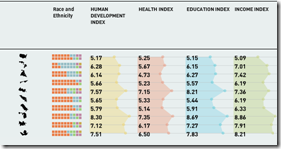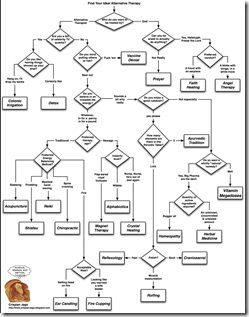Food Archive:
A Century of Meat
18 Mar 2011Go chicken! I wonder why pork has such volatility? (related ethical dietary ponderings; Thanks to Patty Gaffney for the link!)
The World is Getting Fat(ter)
4 Feb 2011Male and female body mass indices by country, from 1980-2008. Some interesting, but perhaps not surprising, observations: European men are consistently fatter than the women, poor people are skinny, and everyone has gotten fatter over the past 18 years. (related article)
Map: Factory Farms
In: Food Interactive Maps
7 Jan 2011Want to know how many cows live in your state? How about the average chickens per farm? The site obviously has a slight bias on food issues, but the data is well presented and the methodology is laid out clearly (something that is missing on too many data visualizations). Personally, I have no problem with killing animals and eating them, and agree that they shouldn’t suffer horribly crappy lives beforehand. (Related blog post).
American Human Development Index
In: Employment Food Housing Interactive Maps Science US Economy
21 Nov 2010Based on the idea that well-being cannot be measured by GDP alone, the Human Development Index looks at over 100 indicators, which you can explore on maps and charts at the most detailed level, or as aggregates (health, education, income). The chart display does seem to have problems separating out Washington DC, however – since we don’t actually have a congressional district — <sigh>. (via)
What we are Eating
In: Food
13 Nov 2010Average American food consumption. (via The Daily Infographic)
Sensory Mapping Timeline
10 Nov 2010An interesting way to map out an experience of positive/negative feelings across all five senses. (via)
I don’t care much for this style of infographic nowadays, but this one managed to hold my attention – something about actually using interesting information and the retro style graphics, I think.
Alternative Medicine Flowchart
19 Oct 2010Poverty and Food
4 Oct 2010An interesting radial variation on a scatter plot, displaying multiple variable from 50 states. It’s . (via the promising new visualization site Visualizing.org)
Rap and Beer
27 Sep 2010The Pop Chart Lab is selling two well designed posters showing the taxonomies of Beer and Rap names.
Marijuana Price Map
19 Sep 2010The data is crowdsourced by consumer submissions. Amusing and interesting. (via)
This is Your Brain on Drugs
15 Sep 2010A new study visualizes the effects of drug use on your brain using SPECT scans. Interesting — though the footnote “colors do not have significant meaning” dilutes the impact quite a bit.
Still, it’s an improvement over what we were taught in the 80s:
Sugar Water Companies
In: Food Global Economy
22 Aug 2010A wonderful (and quite detailed) visualization of the wide world business of sugar water. (via)
China Leads World in Beer Consumption
In: Food Global Economy Maps
18 Aug 2010Forget GDP, China now drinks more beer than either the US or Europe, and is growing by 10 percent a year.
What is Chart Porn?
An addictive collection of beautiful charts, graphs, maps, and interactive data visualization toys -- on topics from around the world.
Categories
- Bailout (118)
- Chartporn Related (3)
- Commentary (21)
- Culture (669)
- Emerging Markets (66)
- Employment (245)
- Environment/weather (133)
- Finance (298)
- Food (92)
- Global Economy (373)
- Graphic Design (bad) (26)
- Graphic Design (general) (183)
- Graphic Tools (23)
- History (158)
- Housing (162)
- Humor (204)
- Innovative (183)
- Interactive (545)
- Internet/tech (97)
- Maps (578)
- News Media (34)
- Politics (329)
- Reference (97)
- Science (331)
- Source: Economist (101)
- Source: FT (92)
- Source: NYT (147)
- Source: Ritholtz (76)
- Source: USA Today (27)
- Source: Washington Post (90)
- Source: WSJ (135)
- Sports (58)
- Stock Market (74)
- Uncategorized (2)
- Updated regularly (76)
- US Economy (553)
- Video (22)
- Aram Korevaar: This chart is now being used as a projection in which countries such as China see themselves as in a [...]
- David: Welcome back Chart Porn! [...]
- J S: Thanks for the great story. Miss reading this blog. Hope to see you more active again. [...]
- jake: I lived in a DC row house for 6 years, and I'm writing this comment from my tiny 1 bedroom apartment [...]
- ronny pettersen: Hilarious and unfortunately accurate... ;-) [...]






















